Indian Wells, Calif. --- Under its recently unveiled SunShot program, the Department of Energy wants to lower the cost of solar energy to $1 a watt by 2017 and to 73 cents by 2030. Those prices include modules, electronics and balance-of-systems.
The price now hovers around $4 and is going down to $3 by the end of 2011.
So how will the solar industry pull that off?
Diamond wire sawing will help, said Dick Swanson, the founder of SunPower and greentech hall of famer, during a keynote at the Solar Industry Summit 2011 earlier this week in Indian Wells, Calif.
“I think it will have a huge impact,” he said. Right now, solar cell makers saw wafers from silicon ingots with highly accurate saws capable of cutting off rounds that are 160 to 180 microns thick. Still, the process turns a lot of pure silicon into expensive dust.
In a few years' time, diamond sawing could help get that figure down to 135 microns thick or less. More wafers per ingot directly leads to a lower price for solar power. (Startups like Crystal Solar, 1366 Technologies, Alta Devices and others are working on techniques for creating even thinner wafers -- think 50 microns -- based on advanced crystal growing and separation techniques.)
Swanson, in fact, believes the DOE roadmap is conservative. By 2020, the DOE is calling for solar modules with rear contacts to maximize output on a module. SunPower already does that. SunPower is also pulling in thin wafers -- of an undisclosed width -- to 2017. The DOE has that on the roadmap toward 2030.
“Get ready for production in the next six years,” he said. “This will dramatically reduce the cost of crystalline silicon modules.”
Price cutting won’t be cheap. Crystalline modules now can sell for $1.48 per watt. Modules will have to drop to 50 cents to hit the $1 per watt goal. The balance-of-system costs will have to plunge from around $1.70 cents to 40 cents. Inverter costs will need to drop to ten cents per watt.
Still, the industry, if anything, has shown it can squeeze costs. The 1980 cost of a solar module was around $21.83 a watt in 2002 dollars, and the current prices exceed the projections from 2005. Sure, those gains in part came from economic dislocations, but they were accomplished nonetheless.
Other things on Swanson’s mind:
--Robots. Crops get harvested with automated tractors. Why can’t solar fields get planted the same way? Another balance-of-system idea that will gain traction will be pre-built solar plants. Solon and SunPower last year unfurled 1 megawatt power-plants-in-a-box. Others, like SunPods, have worked on technologies to be able to truck solar arrays to sites without having the modules fly off in traffic.
“This is going to become a real race, dropping the balance of system costs,” he said.
--Efficiency will grow, but crystalline silicon is hitting a plateau. SunPower, the leader in high-efficiency silicon, has already produced 24.2 percent cells in the lab. The practical limit, other SunPower execs have said, may sit around 25 percent.
--Concentrators will help. A concentrator on crystalline panels can lower the LCOE by 20 percent. “It’s not like it cuts it in half,” he said. Last year, SunPower revealed that it has a concentrator in the works.
--The environment? Well, you have to protect it. The 4:1 standard -- where only one of four acres in a depleted agricultural field or desert area gets used for solar and the rest remain open land -- is becoming more prevalent.
Navigating the demands of wildlife isn’t easy. SunPower had to reconfigure the California Solar Ranch to accommodate the giant king rat (GKR). Then another problem came up: some feared that the kit fox, the predator of the GKR, would hide behind solar foundations to catch them. Foundations had to be redesigned.
--Manufacturing could come back to America. Stephen O’Rourke of Deutsche Bank came out with a study recently that projected that the cost difference in manufacturing in the U.S. versus Asia could be dropped to around ten percent if corporate taxes were eliminated, Swanson said.
Corporate taxation “is a huge, huge driver,” he said. Swanson did not provide solutions on how to prevent CEOs from giving away the benefits in terms of bonuses or dividends.
--Expect more panel diversity. “The modules we make today look to the world the same as the modules from 1975,” he said. We will see modules for homes, BIPV, utility parks, etc. (Note: we have been predicting this since 2009 and hope it comes true.)



